Due to widespread plastic pollution, toxic plastic particles are now present in water sources around the world – including those that are used for tap water.
Our team of water treatment experts has extensively researched and tested the best methods of removing microplastics from drinking water. We’ve shared our top recommended solutions, based on our own insight and real data from scientific studies, in this guide.
📌 Key Takeaways:
- The best way to remove microplastics from your tap water is with a water filter that’s capable of trapping or rejecting these tiny particles.
- Filters that can remove microplastics include ceramic filters, some carbon filters, nanofiltration, ultrafiltration, distillation, & reverse osmosis systems.
- Sediment, ion exchange, KDF, catalytic carbon, and activated alumina are NOT effective methods of microplastics removal.

Table of Contents
- ⚗️ Reverse Osmosis Systems
- 🚰 Distillation
- 🔮 Activated Carbon Filters
- 📥 Ceramic Filters
- 🚿 Other Membrane Filters (Microfiltration, Ultrafiltration, and Nanofiltration)
- 🔎 Other Solutions for Removing Microplastics
- ⚠️ Which Water Treatment Methods Are NOT Effective for Microplastics Removal?
- 📝 Final Word
- ❔ Removing Microplastics From Water: FAQ
⚗️ Reverse Osmosis Systems
Reverse osmosis is one of the most effective, thorough forms of water purification, removing microplastics and dozens of other total dissolved solids in water.
A reverse osmosis membrane has a pore size of around 0.0001 microns – small enough to remove all micro- and nanoplastics (MNPs).
Most reverse osmosis systems are POU units, such as countertop systems and under-sink systems. Point-of-entry systems are also available, but they’re not as popular because they’re expensive and waste a lot of water.
See the most efficient home reverse osmosis systems on the market 👈
How it Works
Reverse osmosis systems send water at a high pressure through multiple filtration stages, including a sediment filter, several carbon filters, and a semi-permeable membrane.
When water is forced through the membrane, contaminants larger than the membrane pores – including microplastics, bacteria, metals, minerals, many chemicals, and salts – are rejected. This process is known as membrane separation.
The rejected contaminants are flushed out of the RO system via a drain line along with a small amount of wastewater.
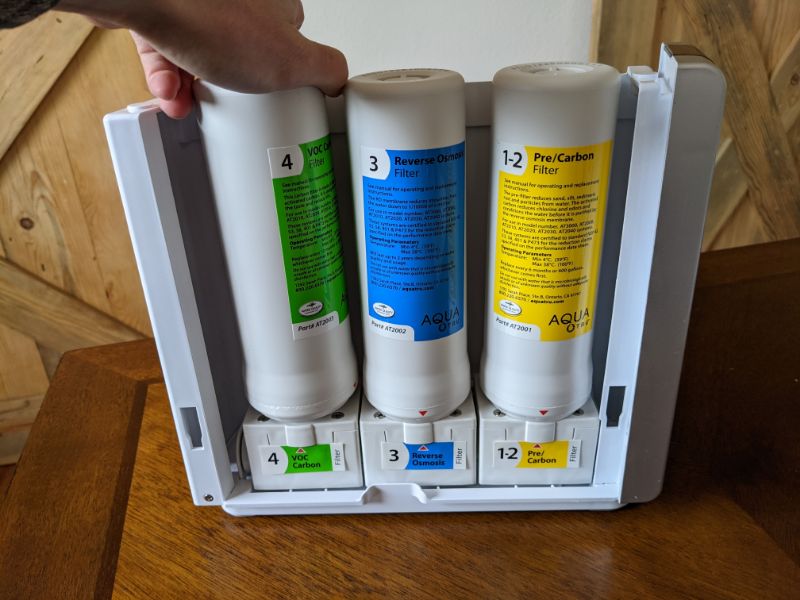
The Evidence
- This 2022 research paper lists reverse osmosis as one of the main technologies for the removal of microplastics, noting that polyethylene microplastics could be completely removed using the RO process “even without co-treatment of coagulation”.
- Reverse osmosis was also cited as an “efficient and cost-effective” method of microplastic removal by EPA scientists in a 2021 paper on identifying and removing micro- and nanoplastic particles.
Best For
Reverse osmosis is one of the most comprehensive purification solutions for household tap water. It’s the best option for folks with big budgets who want the best protection against tiny plastic particles across a range of sizes, and the majority of other impurities, in their drinking water.
🚰 Distillation
Water distillation is another highly effective microplastics removal method that boils water and captures the clean steam in a separate container, where it condenses back into pure water. The impurities, including microplastics, are left behind in the boiling chamber.
Most home water distillers are countertop units, but floor-standing units are also available.
Check out our review of the top home water distillers in 2025 👈
How it Works
A water distiller produces pure water using the distillation process – boiling tap water until it evaporates, then capturing and cooling the steam so that it condenses into a separate container.
The majority of impurities, including microplastics, are unable to vaporize with the water molecules. They remain in the distillation pot and can be removed from the system when you clean it out.
Some water distillers have a small activated carbon filter in their spout, which captures contaminants that are able to vaporize and condense with the water.
The Evidence
Distillation isn’t as thoroughly researched for microplastics removal as the other methods we’ve shared, perhaps because this process is already so widely known as a water purification solution.
- This 2023 study evaluated the removal of microplastics from seawater using membrane distillation systems, with high removal efficiencies (≥99 %) found across all results.
Best For
Water distillers are as comprehensive as reverse osmosis and produce clean, pure water. That makes them another great fit for people who want to remove microplastics and as many other contaminants as possible from their water.
They’re cheaper than RO systems and require no filter changes, so they’re better for smaller budgets. But they take much longer to purify water – around 5 hours for every 1 gallon purified – so they’re not suitable for folks who want an instant water purification solution.
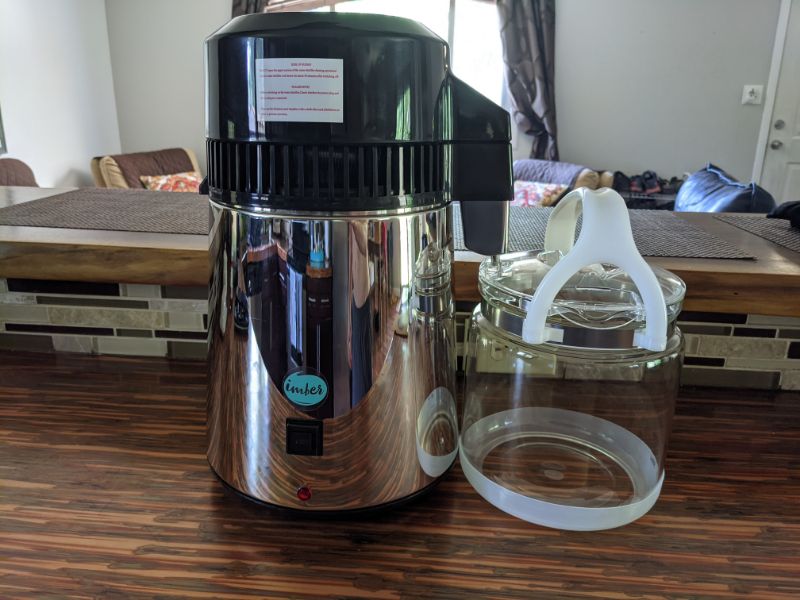
🔮 Activated Carbon Filters
Some activated carbon block filters and granular activated carbon filters can remove larger plastics of around 0.5-10 microns in size, but they aren’t an effective solution against smaller plastics.
Activated carbon water filter media is found in a range of filter types, including water pitcher filters, reverse osmosis systems, under-sink systems, and whole-home filter units. AC filters may be used as standalone filters or combined with other filtration media to enhance their performance.
See the best activated carbon water filters right here – ranked & reviewed 👈
How it Works
Activated carbon filters remove contaminants by attracting and binding them to their media, using a process called adsorption. Chlorine, Particulates class I (which includes microplastics), and poor tastes and odors can all be addressed by this filter media.
The size of the activated carbon filter’s pores determines the size and scope of the microplastics removed. Filters with a smaller pore size of 1 micron or less can trap a broader spectrum of plastic particles of varying sizes.
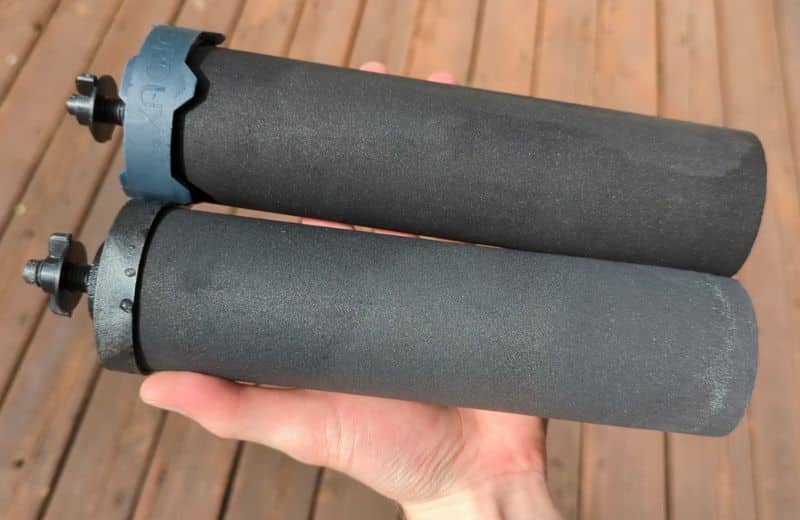
The Evidence
- This 2023 research paper on using POU filters to remove microplastics noted that activated carbon filters certified in accordance with NSF-53 and NSF-42 standards “may be effective” in removing microplastics greater than 1µm in size.
- A 2022 study on microplastic removal from water and wastewater by carbon-supported materials concluded that activated carbon biochars are an “efficient filter material” for microplastic particles, but noted that the surface chemistry, shape, and size of the microplastics, as well as water saturation and ionic strength, affected the filter’s overall performance.
Best For
Activated carbon filters are significantly more affordable than reverse osmosis systems, but they don’t purify water – they only reduce select contaminants. They’re the best choice for people with smaller budgets who primarily want to address microplastics in their drinking water, as well as poor tastes and odors.
📥 Ceramic Filters
Ceramic filters can physically filter out most microplastics because they have a smaller pore size of around 0.2 microns, so they provide a barrier that prevents these suspended impurities from passing through the filter media.
Due to their low micron rating, these filters can also address some microorganisms like bacteria. They’re often found in countertop gravity-fed filtration systems and portable water filters.
How it Works
Ceramic water filters use all-natural ceramic technology to reduce microplastics in water.
As water flows through a ceramic filter, particles that are too large to fit through the filter pores become trapped in the filter media.
These contaminants collect on the filter surface over time. Some ceramic filters can be scr\ubbed under running water to remove the impurities and extend their lifespans, while others need to be replaced once their flow rates reduce significantly.
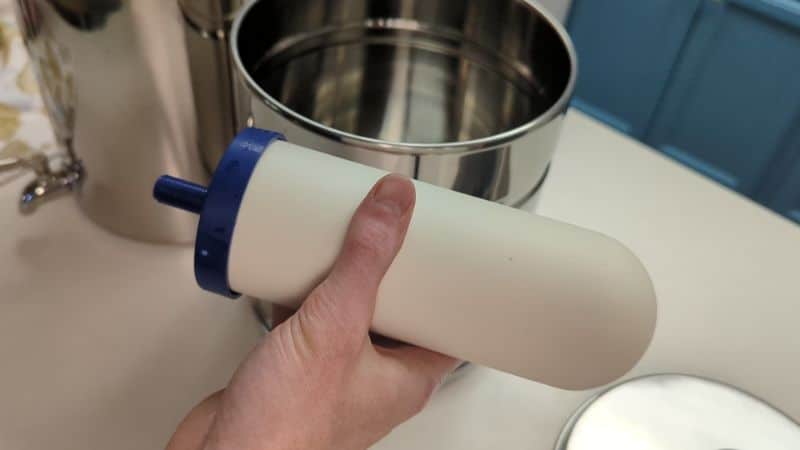
The Evidence
- This 2023 study on the removal of microplastics in wastewater by ceramic microfiltration found that using ceramic membranes after activated sludge treatment further removed >72 % of microplastics.
- A 2024 evaluation of low-cost ceramic filters for decentralized water treatment noted that a silica-based ceramic hollow fiber microporous membrane “effectively removed” various types of microplastics, with a removal efficiency that exceeded 88%.
Best For
Ceramic filters are most commonly found in gravity-fed countertop units and emergency preparedness systems. For that reason, they’re a good choice for people looking for an affordable, potentially washable and reusable filter that effectively addresses microplastics, bacteria, sediment, and other suspended particles of various sizes that affect water quality and safety.
🚿 Other Membrane Filters (Microfiltration, Ultrafiltration, and Nanofiltration)
There are three types of membrane filters that can all address microplastics in tap water with varying levels of effectiveness. These are microfilters, ultrafiltration membranes, and nanofilters.
Membrane filtration media is most commonly found in emergency preparedness filters and portable filtration systems. They may be combined with other media, like activated carbon media, or they may be used alone.
How it Works
Membrane filters act as a sieve, allowing water molecules to pass through while rejecting or blocking all larger impurities, including microplastics.
- Microfiltration allows the largest contaminants through, with a pore size of 0.1-10 microns.
- Ultrafiltration is similar to, but not quite as thorough as, reverse osmosis. Ultrafiltration membranes have a smaller pore size of 0.02-0.05 microns.
- Nanofiltration media has a pore size of 0.001-0.01 microns and becomes progressively finer from the filter exterior to the core, trapping smaller and smaller contaminants.
Some membrane filters can be flushed or backwashed to remove the accumulated contaminants, restoring their flow rates so they can be used again and again.

Continue Reading: Best water filters for microplastics in 2024
The Evidence
- This 2022 study on ultrafiltration for microplastics removal found that using ultrafiltration at a water treatment plant increased microplastic reduction efficiency from 86.14% (using conventional treatment only) to 96.97%.
- Another 2022 study on membrane processes like microfiltration and nanofiltration concluded that these offer a more efficient microplastics removal solution than typical processes used at water treatment facilities. However, the study also commented that microplastics re-contamination within the water distribution network might occur after treatment.
An important note about membrane filters for removing microplastics: emerging evidence suggests that nanofilters may actually increase the concentration of microplastics in water due to the leaching of synthetic materials from the membrane itself. Further research is required to confirm the safety of membrane filtration processes and determine whether these might do more harm than good as a microplastics removal method.
Best For
Membrane filtration is most often used in portable water filters and can also remove microorganisms (bacteria, protozoa, and sometimes viruses). These filters are ideal emergency preparedness solutions, and they’re also a good choice for folks who want to address microplastic pollution in natural water sources, like rivers and lakes, while camping or hiking in the wilderness.
🔎 Other Solutions for Removing Microplastics
There are several other water treatment methods that have also shown promise in reducing microplastics, but for one reason or another, they’re not among our top recommended solutions.
These include:
- Boiling water – Surprisingly, a recent study concluded that boiling water can remove at least 80% of select microplastics: polypropylene, polystyrene, and polyethylene, with a micron size of 0.1-150 μm. However, this study is limited to water with specific parameters (hard water with >120 mg L–1 of calcium carbonate), and filtration is still a necessary step. Until more research is conducted in this area, we can’t conclusively recommend boiling your water as a primary method of microplastics removal.
- Fungal pelletization – One of the emerging methods of removing microplastics in large-scale water treatment is called fungal pelletization, which has previously been studied for wastewater treatment. This process involves using various fungal strains to attract microplastics, where they form pellets, making them easier to remove from the water. This method could solve the problem of the inability to address tiny microplastics in wastewater, but it’s not feasible or practical for at-home use, which is why it isn’t among our top recommendations.
⚠️ Which Water Treatment Methods Are NOT Effective for Microplastics Removal?
Due to their microscopic size, microplastics can’t be removed by all water filter methods. Some of the filtration methods that can’t capture microplastics are:
Sediment Filters
Sediment filters typically have a pore size of 5-100 or bigger, so they’re too large to capture microplastics.
These filters are predominantly used as a pre-filtration stage to remove larger suspended particles, like sand, silt, dirt, rust, and other debris, from water. Microplastic particles are small enough to pass through a sediment filter’s pores with the water molecules.
Ion Exchange Filters
Ion exchange filters exchange harmful cations (ions with a positive charge) or anions (ions with a negative charge) with safe alternatives.
The most popular example of ion exchange is water softening, which uses cation exchange to remove hardness minerals, replacing them with sodium or potassium ions to balance out the water’s charge. Ion exchange resins are also used in some point-of-use water filters, like water filter pitchers.
Microplastics don’t have a charge, so they can’t be removed from water using this method.
KDF Filters
There are a few different types of KDF filters, which address different groups of contaminants. The most common are KDF-55 and KDF-85.
These media address chlorine and heavy metals, and inhibit bacteria and algae growth, but we couldn’t find any research to support their ability to reduce microplastics.
Catalytic Carbon Filters
Catalytic carbon filters are made from enhanced activated carbon media, which has additional contaminant reduction abilities (it can also reduce chloramine and hydrogen sulfide).
As with normal activated carbon filters, it’s possible that catalytic carbon media can reduce some microplastics, depending on the filter pore size. However, this media generally isn’t an effective way to address microplastics, and there are better alternatives to consider.
Activated Alumina
Activated alumina filtration media’s main purpose is to reduce fluoride and arsenic, and it’s often used in dedicated fluoride filters for this reason.
We couldn’t find any evidence that activated alumina media can remove microplastic particles.
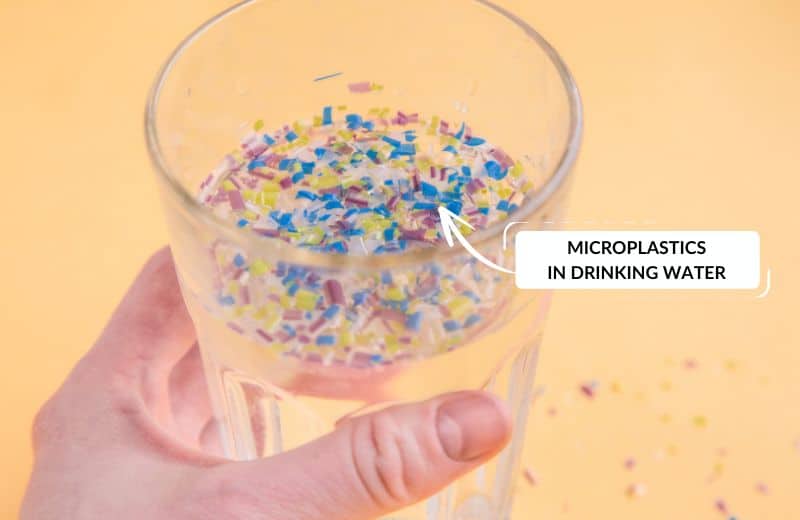
📝 Final Word
If you’re concerned about the health effects of drinking microplastics in your tap water, it’s time to take action. Choose the best microplastic removal solution for you based on your budget, your preferences, and the contaminants present in your water.
Also look at other ways to reduce your microplastic exposure at home.
Avoid drinking bottled water – many plastic water bottles leach dangerous plastic residue into water. Use non-plastic containers for food storage, especially for microwaving food. Air-dry your clothes and avoid wearing synthetic clothing.
The best long-term solution is to avoid using plastic as much as possible. Ditch the plastic straws, plastic utensils, plastic food containers, and other single-use plastics. This will help limit the environmental factors of plastic waste, too.
Read more: How to test for microplastics in water
❔ Removing Microplastics From Water: FAQ
Can you filter microplastics out of water?
Yes, you can filter microplastics out of water. However, not all water filters can remove microplastics. The best filters for microplastic removal are reverse osmosis filters, ceramic filters, nano filters and other membrane filters, water distillers, and some activated carbon filters.
Does a Brita filter remove microplastics?
Yes, but only the Brita Elite filter is listed as capable of removing microplastics. The Brita Standard filter can only remove a handful of common tap water contaminants, including chlorine, poor tastes and odors, and some heavy metals.
How effective are microplastic filters?
Microplastic filters – or water filters designed to remove microplastics – are generally capable of between 70% and 99.9% of microplastic removal. No matter how thorough the filtration, there’s always the chance that some microplastic particles will remain in your water, but in much smaller quantities than before.
How do you prevent microplastics in drinking water?
Preventing microplastics in drinking water typically isn’t possible because plastic pollution is already so widespread; plastic particles are found in tap water around the world. New methods are being developed for effectively removing microplastics from water at the treatment plant, but water may become recontaminated on its journey to the faucet. Rather than trying to prevent microplastics pollution in the first place (which would involve eliminating plastic use and reversing the effects of plastic consumption all over the world), the more feasible solution is to remove plastics from your own tap water supply at home.
Can your body get rid of microplastics?
Yes, the human body can get rid of microplastics with normal fecal excretion. Certain foods, such as green tea and leafy greens, are also thought to mitigate the human health effects of microplastic consumption. However, recent research has found that microplastics can be absorbed into the bloodstream, and it isn’t clear whether – or how – these particles are removed from the body.

